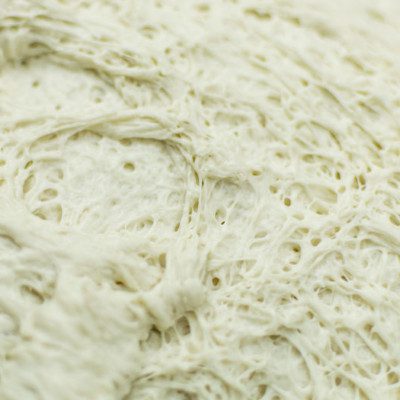Origin
This type of preferment was developed by Italian bakers. The production technique of biga was developed just a few years after the discovery of baker’s yeast.
In the 19th century, some bakers in Europe walked away from the use of sourdough for the sake of adopting faster production techniques, but needed to recover some of the flavor and aroma that was given up in that process.
Biga was then made fresh every day and added to recipes at different levels, depending on the formula, for routine production of traditional Italian bakery goods.1,2
Function
Due to its stiff consistency (low hydration level), it provides strength to dough, which is actually its original purpose. Bread made with biga has a complex flavor due to its long fermentation period.
The long fermentation occurs because the yeast’s movement and metabolic activity are impeded or slowed down by the low level of free water available. Yeast also propagates slower and partially consumes the carbohydrates in the dough.
Biga is often used in breads that need a light and open structure, i.e., more cells. It helps to preserve bread by extending its shelf life due to its higher acidity level, or lower pH.
Production:3
A traditional biga is prepared by using flour, water, and yeast. The quantities can be as follows:
- Bread flour: 100%
- Water: 50–60%
- Fresh yeast: 0.8–1.5% or
- Instant yeast: 0.1%
The mixture is only mixed to form a homogeneous dough (full gluten development is not the target in this case), and then allowed to ferment for 8–16 hours at a temperature of 15–20°C (59–68°F).
The fermentation conditions (time, temperature) may be modulated depending on the baker’s convenience and type of bread being prepared. When ripe, it will be domed and just beginning to recede in the center.
Application
When biga has been given the right fermentation, the remaining flour and water are added on the dough side. After 30–60 mins of floor time, the dough is divided/cut, shaped, and left to proof one last time for about 30–60 mins, and then baked.
Bakers should use biga carefully when also using stronger flour, to avoid hurting extensibility. If dough extensibility is compromised, higher hydration or autolyse will help regain a better balance.1
Biga is used in the production of a variety of bakery products, which include:
- Ciabatta (40% biga in final dough formula)
- Brioche
- Stollen
- Filoncini burro y nocci (20% biga in final dough formula)
- Breads made from high-hydration doughs
- Danish dough (67% biga in final dough formula)
References
- Suas, M. “Fermentation.” Advanced Bread and Pastry: A Professional Approach, Delmar, Cengage Learning, 2009, pp. 86–88.
- Stella Culinary, “The Three Mother Preferments and How to Use Them.” https://stellaculinary.com/content/three-mother-preferments-and-how-use-them. Accessed 30 March 2018.
- Hamelman, J. Bread – a Baker’s Book of Techniques and Recipes, 2004, p. 105.

